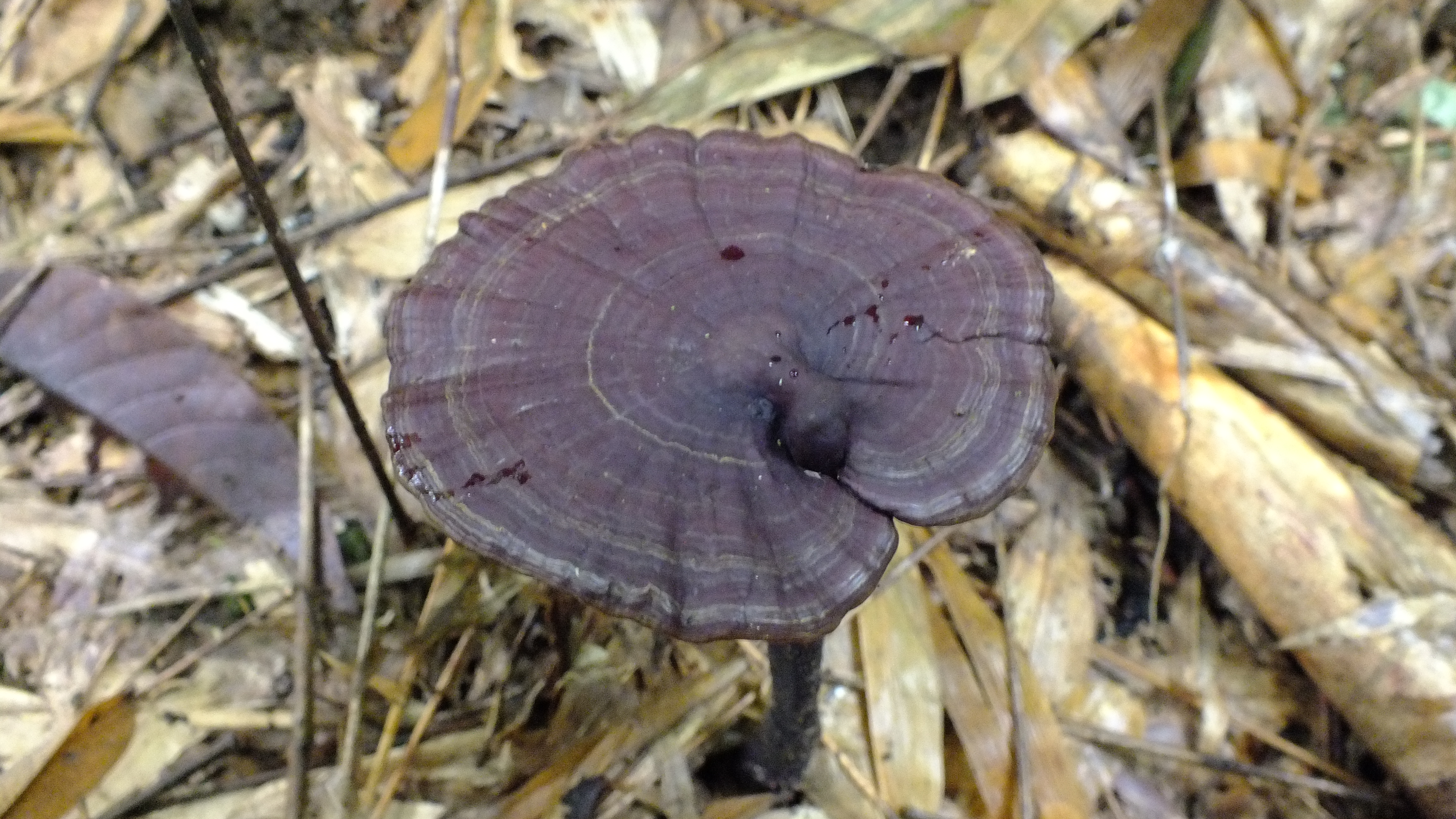ເລກລຳດັບທີ: 126
ລະດັບການຮວບຮວມຂໍ້ມູນ: ເກີອບສົມບູນ
ປັບປູງຄັ້ງລ່າສຸດ: N/A
ເຫັດກ້ານຈອງດຳ
Wood-decay Fungi
Sanguinoderma rugosum (Blume & T.Nees) Y.F.Sun, D.H.Costa & B.K.Cui
ເຊື້ອເຫັດ
ເຊື້ອຣາເກີດຕາມໄມ້
×
ຊື່ທ້ອງຖີ່ນ:
Thai: Cwak Ngu Si Ob Xiew, Cwak Ngu Kha Khaeng, Ling Jeu Dam Dan
Chinese: Jiǎ zhī [假芝] ( Thai: Cwak Ngu Si Ob Xiew, Cwak Ngu Kha Khaeng, Ling Jeu Dam Dan
Chinese: Jiǎ zhī [假芝])
ຊື່ພ້ອງ
:
Scindalma rugosum (Blume & T. Nees) Kuntze
Polyporus sandakanii Lloyd
Amauroderma rugosum var. latiporum Corner
Fomes rugosus Nees
Polyporus sandakanii Lloyd
Amauroderma rugosum var. latiporum Corner
Fomes rugosus Nees
ຊື່ສະກຸນ:
Ganodermataceae
ຊະນິດໃກ້ຄຽງ:
ບັນຍາຍລັກສະນະທາງພືດສາດ:
ດອກເຫັດລັກສະນະຄ້າຍຄືຈອງ, ສູງປະມານ 20 ຊມ. ໝວກເຫັດ ກວ້າງ 2−15 ຊມ, ຮູບເຄີ່ງວົງມົນ ແລະ ບໍ່ລຽບ ຫຼື ຄ້າຍຮູບວີ, ເນື້ອບາງ ຫຼື ໜາ, ໜຽວ ແລະ ແຂງ, ມີຮ່ອງນູ່ນ ແລະ ຍັບຍໍ້, ໂດຍທົ່ວໄປຈະເປັນສີນ້ຳຕານເຂັ້ມ ແລ້ວປ່ຽນເປັນສີດຳ, ເມື່ອແກ່ຈະດຳເສົ້າ (ລວມທັ້ງຂອບ), ດ້ານລຸ່ມຈະເປັນສີເທົາຈ່າງໆ, ໜວກທີ່ກຳລັງ ຈະເລີນເຕີບໂຕເຕັມທີ່ຈະເປັນສີນ້ຳຕານຄ້າຍໝາກເກົາລັດ, ຂອບມັກຈະປັນສີຂາວ, ຂອບເປັນຮູບຕັດ.
ນິເວດວິທະຍາ
ເຂດກະຈາຍພັນທົ່ວໂລກ:
N/A
ເຂດກະຈາຍພັນໃນລາວ
:
ເຂດກະຈາຍພັນຕາມພູມສັນຖານ
:
ສະເພາະຖິ່ນໃນລາວ:
N/A
ຮຸກຮານ
:
N/A
ສະຖານະພາບການອະນູຮັກ IUCN
:
N/A
ສະຖານະພາບການອະນຸຮັກແຫ່ງຊາດລາວ
:
N/A
ການນຳໃຊ້
ປະເພດການນຳໃຊ້:
ພືດເປັນຢາ
ບັນຍາຍການນຳໃຊ້:
ຢາພື້ນເມືອງ: ຢາພື້ນເມືອງແມ່ນໃຊ້ເພື່ອຮັກສາການອັບເສັບກະເພາະອາຫານ, ຂັບປັດສະວະ ແລະ ປ້ອງກັນ ພະຍາດມະເຮັງ (Chan et al. 2015). ການວິເຄາະທາງໂພຊະນາການຂອງເສັ້ນໃຍແຫ້ງຂອງ A. rugosum (KUM 61131) ຈາກການປູກ ພົບວ່າມີທາດ ຄາຣ໌ໂບໄຮເດຣດ, ໂປຣຕີນ, ເສັ້ນໃຍອາຫານ, ຟົສຟໍຣັດ, ໂປເທສຊຽມ ແລະ ໂຊດຽມ
ການປູກ ການລ້ຽງ:
N/A
ລະດູການເກັບກູ້:
ການຕະຫຼາດ ແລະ ຕ່ອງໂສ້ມູນຄ່າ:
N/A
ການຄຸ້ມຄອງຈັດການ
N/A
ໂພຊະນາການ
ຄຸນຄ່າທາງໂພຊະນາການ:
ບັນຍາຍຄຸນຄ່າທາງໂພຊະນາການ:
N/A
| ສານອາຫານ | /100g | ໝາຍເຫດ |
|---|---|---|
| ໂປຣຕີນ | N/A | N/A |
| ຄາໂບໄຮເດຣດ | N/A | N/A |
| ໄຂມັນ | N/A | N/A |
| ວິຕາມິນ | N/A | N/A |
| ແຮ່ທາດ | N/A | N/A |
| ເສັ້ນໄຍ | N/A | N/A |
ອ້າງອິງ
ເຄດິດຮູບພາບ:
ອ້າງອິງ:
P.−M. Chan, G. Kanagasabapathy, Y.−S. Tan, V. Sabaratnam and U. Rani Kuppusamy. 2014. Amauroderma rugosum (Blume & T. Nees) Torrend: Nutritional Composition and Antioxidant and Potential Anti-Inflammatory Properties. Evidence-based Complementary and Alternative Medicine 2013(4):10.
Chan, Mun P. (2016) Amauroderma rugosum (Blume & T. Nees) torrend attenuates the pathophysiological cascade of inflammatory events in epileptogenesis/ Chan Pui Mun. PhD thesis, University of Malaya.
Mortimer P.E., Xu, J., Karunarathna, S.C. & Hyde K.D. 2014. Mushrooms for trees and people: a field guide to useful mushrooms of the Mekong region. The World Agroforestry Centre, East Asia, Kunming, China.
Chan, Mun P. (2016) Amauroderma rugosum (Blume & T. Nees) torrend attenuates the pathophysiological cascade of inflammatory events in epileptogenesis/ Chan Pui Mun. PhD thesis, University of Malaya.
Mortimer P.E., Xu, J., Karunarathna, S.C. & Hyde K.D. 2014. Mushrooms for trees and people: a field guide to useful mushrooms of the Mekong region. The World Agroforestry Centre, East Asia, Kunming, China.
ຜູ້ສ້າງ Factsheet:
ຜູ້ກວດສອບ Factsheet:
,
